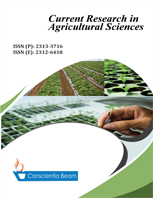Constructed Wetland Effluent Irrigation as a Potential Water and Nutrient Source for Vegetables
DOI:
https://doi.org/10.18488/journal.68.2021.82.65.70Abstract
A field study was conducted to evaluate the influence of constructed wetland effluent irrigation on the yield and productivity of Fluted Pumpkin (Telfairia occidentalis). The Telfairia occidentalis were planted in 12 beds (6 beds per treatment) measuring 1m wide, 3m long and 0.2m high. The plants were grown for 8 weeks before they were harvested. The experimental plots were irrigated with secondary treated effluent from an experimental constructed wetland treating slaughterhouse wastewater. The control treatment involved the irrigation with tap water. The results show that the effluent used in the study was rich in nutrients and organic content. The result also revealed that the mean biomass yield of 146.14g, mean leaf length of 10.10cm, mean height of 97.50cm, mean leaf width of 5.36cm and mean number of branches of 16.24 were significantly higher for the secondary treated slaughterhouse effluent irrigated plots compared to the values obtained for the control plots, indicating that effluent irrigation has a great potential to serve as not only a water source for vegetable cultivation, but also as a nutrient source for increased productivity.

